Since we did not have a designated student blogger writing for January 14, I’d like to add a brief report on this day, to round out this blog: it will now cover all the days of our class, Jan. 3-19, 2023.
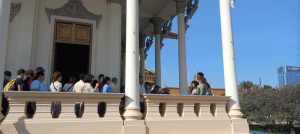 In the morning we left our hotel in downtown Phnom Penh, Cambodia’s capital city, for a short bus ride to the Royal Palace. We enjoyed a 2-hour guided tour of the palace, as well as the affiliated Silver Pagoda (Wat Preah Keo, a.k.a. Temple of the Emerald Buddha), one of the most important Buddhist places in Cambodia and in the capital, also serving the royal family and its young boys, who will do their traditional time as a young monk at this site.
In the morning we left our hotel in downtown Phnom Penh, Cambodia’s capital city, for a short bus ride to the Royal Palace. We enjoyed a 2-hour guided tour of the palace, as well as the affiliated Silver Pagoda (Wat Preah Keo, a.k.a. Temple of the Emerald Buddha), one of the most important Buddhist places in Cambodia and in the capital, also serving the royal family and its young boys, who will do their traditional time as a young monk at this site.
The present King, Norodom Sihamoni, lives in a special area on the palace grounds. Our guide informed us that whenever the King is present, the royal blue flag will be flying over the buildings — as it did today. (You can see it on the right of this picture, which shows our group taking in the explanation of our Cambodian guide)
King Sihamoni took over in 2004, when his father, the famous Norodom Sihanouk (whom we saw a film about, The Nine Lives of Norodom Sihanouk) abdicated, and later passed away. Solemn ceremonies were held right here on the palace grounds, both for the enthronement of the new king (2004), and the funeral of his father (in 2013). We saw the stupa (commemorative monuments) of several other prominent royal figures, on the palace grounds.
Our tour included the throne hall, which is also used when new foreign ambassadors present their accreditation to Cambodia’s current King. We also saw other major buildings, including the “Moonlight Pavilion”, an open-air pavilion mainly serving as the stage of Khmer classical dance performances (of the kind we saw in the film, The Tenth Dancer). In another hall were displays of costumes and royal paraphernalia, as well as, curiously, displays of ceramics going back to prehistoric times. The Napoleon Pavilion, in French architectural style said to have been donated by France, was closed for renovations and could only be seen by peeking through the mesh of the protective construction screens. We learned that many of the buildings, even those in Cambodian style, date to French colonial times, and many have been recently reconstructed, including the Silver Pagoda itself; it all speaks volumes about the living continuity of the monarchy and its traditions.
We saw the outdoor Angkor Wat miniature (which is strangely incomplete, so that it does not show the Western Gate where the original statue of Vishnu was moved after the temple was re-dedicated to Buddhism — as we learned about when visiting the real Angkor Wat, in the early days of our class). (In my only photo I managed to cut off the Western end! Maybe I can blame it on the boys feeding potato chips to the royal fish in the moat! )
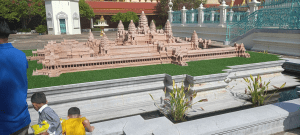
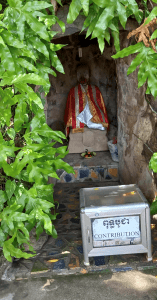 The royal palace, just as any house in Cambodia, has spirit houses providing for ancestral spirits of the site, and our guide also pointed out a neak ta spirit statue placed in a corner of a wooded grove. We noticed the lavishly applied lipstick, reminiscent of certain neak ta we had seen in Siem Reap on the grounds of the King’s residence there, in Cambodia’s second city; — complicating the common designation of neak ta as ‘popular religion.’
The royal palace, just as any house in Cambodia, has spirit houses providing for ancestral spirits of the site, and our guide also pointed out a neak ta spirit statue placed in a corner of a wooded grove. We noticed the lavishly applied lipstick, reminiscent of certain neak ta we had seen in Siem Reap on the grounds of the King’s residence there, in Cambodia’s second city; — complicating the common designation of neak ta as ‘popular religion.’
At the Silver Pagoda, other than the lavish Buddhist statuary and likenesses of past kings, and the silver tile floor, one highlight was the gigantic, incredibly rich painted mural of the complete(!) Ramayana (Reamker) story which runs all around the inner wall of the compound. It was painted in 1903–1904, by a large team of painters. There is a roof that thankfully shields admirers from the hot sun!
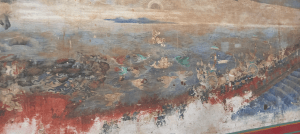 Here, a scene from the Silver Pagoda Ramayana mural depicting the ultra-famous battle between Rama’s loyal monkey army trying to build a stone bridge to mythical Lanka, held by the evil demon king Ravana. The fish of the ocean are busy helping Ravana by throwing away the stones — actually this scene lives on as a famous classical dance scene, which we saw reenacted at the Kanell restaurant in Siem Reap on Jan. 3. I’ll never forget the cute fish flaps on the back of the dancers playing the fish, busily throwing away the ‘stones’ [foam blocks!] of the monkey army ‘corps of engineers.’
Here, a scene from the Silver Pagoda Ramayana mural depicting the ultra-famous battle between Rama’s loyal monkey army trying to build a stone bridge to mythical Lanka, held by the evil demon king Ravana. The fish of the ocean are busy helping Ravana by throwing away the stones — actually this scene lives on as a famous classical dance scene, which we saw reenacted at the Kanell restaurant in Siem Reap on Jan. 3. I’ll never forget the cute fish flaps on the back of the dancers playing the fish, busily throwing away the ‘stones’ [foam blocks!] of the monkey army ‘corps of engineers.’
 Our tour ended at the royal elephant museum near the gates, showing royal elephant carriage palanquins, and the like. We had lunch at the Warang Bali, a small Indonesian restaurant located nearby, very close to the National Museum. This restaurant had been hotly recommended by Cornell’s Khmer teacher, Hanna Phan, and certainly lived up to it!
Our tour ended at the royal elephant museum near the gates, showing royal elephant carriage palanquins, and the like. We had lunch at the Warang Bali, a small Indonesian restaurant located nearby, very close to the National Museum. This restaurant had been hotly recommended by Cornell’s Khmer teacher, Hanna Phan, and certainly lived up to it!
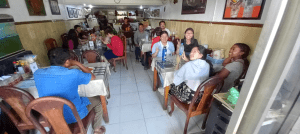 In the afternoon, we spent several hours, 1-4pm or so, at the Bophana Audio-Visual Centre [ https://bophana.org/ ]. We were enthusiastically received by Mr. Sopheap Chea, the Executive Director, and by Dr. Courtney Work (anthropology PhD from Cornell, now teaching in Taipei, an expert on contemporary and rural Cambodia). Sopheap Chea gave a presentation on the work of the Bophana documenting the recent history of Cambodia, especially the Pol Pot/Khmer Rouge period and genocide, and also contemporary issues.
In the afternoon, we spent several hours, 1-4pm or so, at the Bophana Audio-Visual Centre [ https://bophana.org/ ]. We were enthusiastically received by Mr. Sopheap Chea, the Executive Director, and by Dr. Courtney Work (anthropology PhD from Cornell, now teaching in Taipei, an expert on contemporary and rural Cambodia). Sopheap Chea gave a presentation on the work of the Bophana documenting the recent history of Cambodia, especially the Pol Pot/Khmer Rouge period and genocide, and also contemporary issues.
Then, the two had arranged an afternoon watching three films made by recently minted young Cambodian female filmmakers: “Contemplation,” by Kon Sreynith, a gripping film about garbage scavengers near Phnom Penh; “Opposite” by Socheata Chen et al, about schooling and development among the Tampuan ethnic minority; and “Following Dad’s Path,” by Kol Sovanpichvicheka, about illegal fishing in the Mekong. The subtitles had only just been added the day before, to accomodate our group at this premiere showing.
Following the film showing, we had an extended discussion with the filmmakers, facilitated and translated by Sopheap Chea and by Dr. Courtney Work — but often directly with the filmmakers who spoke some English as well, and who told us about their filmmaking, how they overcame the challenge of working with ordinary Cambodians, and about their engagement in contemporary social and environmental issues in their country.
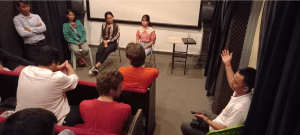
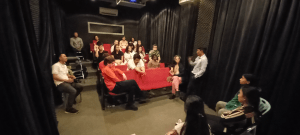 The visit ended with a tour of the center given by Sopheap Chea, who welcomed us to return in the future — both to avail ourselves of the audiovisual resources of the Bophana, and to collaborate in new filmmaking projects.
The visit ended with a tour of the center given by Sopheap Chea, who welcomed us to return in the future — both to avail ourselves of the audiovisual resources of the Bophana, and to collaborate in new filmmaking projects.
At one point, we caught a glimpse of the saved set of the stop-motion animated figure Cambodian film The Missing Picture, on the Pol Pot era, which was shot partly at the Bophana (and was shown in Hanna Phan’s preparatory class on Cambodia, Fall 2022).
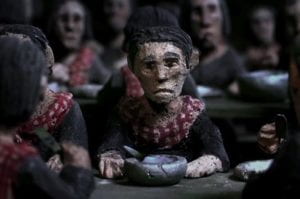 Screenshot from The Missing Picture, from https://bophana.org/events/the-missing-picture-online/
Screenshot from The Missing Picture, from https://bophana.org/events/the-missing-picture-online/